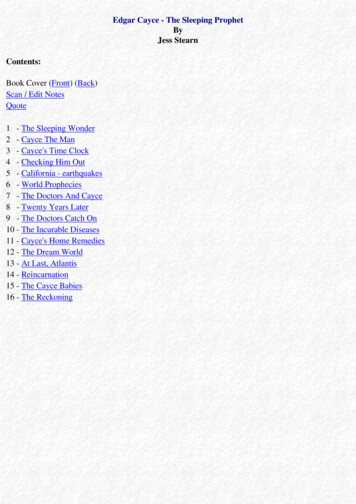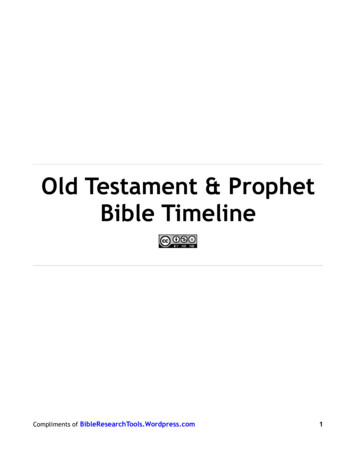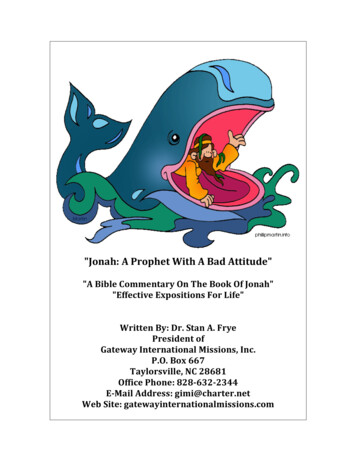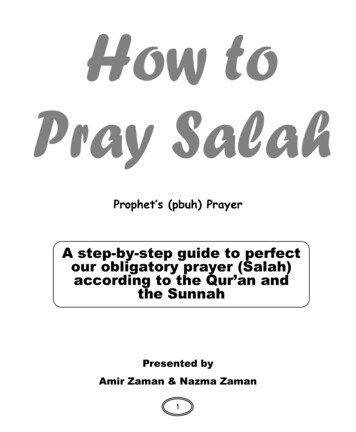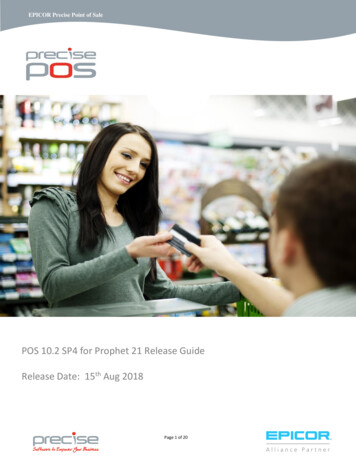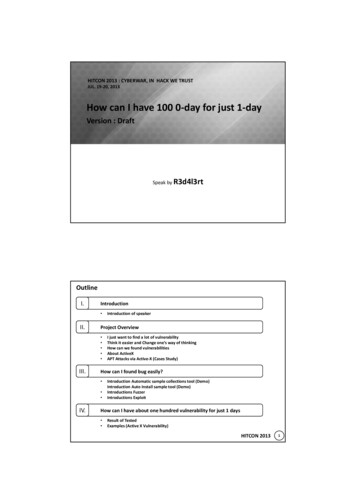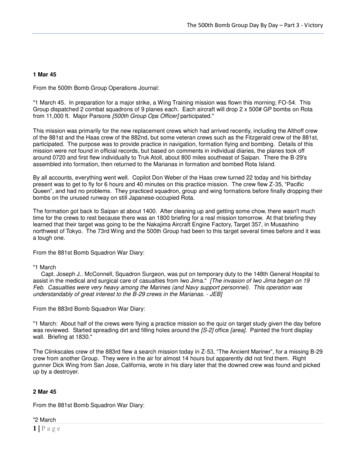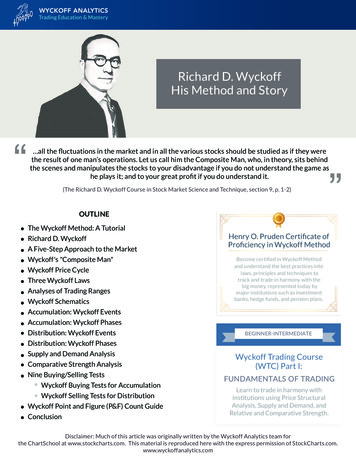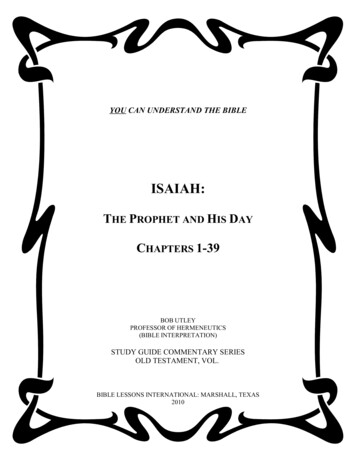
Transcription
YOU CAN UNDERSTAND THE BIBLEISAIAH:THE PROPHET AND HIS DAYCHAPTERS 1-39BOB UTLEYPROFESSOR OF HERMENEUTICS(BIBLE INTERPRETATION)STUDY GUIDE COMMENTARY SERIESOLD TESTAMENT, VOL.BIBLE LESSONS INTERNATIONAL: MARSHALL, TEXAS2010
Copyright 2001 by Bible Lessons International, Marshall, Texas (Revised 2006)All rights reserved. No part of this book may be reproduced in any way or by any means without the writtenpermission of the publisher.Bible Lessons InternationalP. O. Box 1289Marshall, TX 75671-12891-800-785-1005ISBNThe primary biblical text used in this commentary is:New American Standard Bible (Update, 1995)Copyright 1960, 1962, 1963, 1968, 1971, 1972, 1973, 1975, 1977, 1995 byThe Lockman FoundationP. O. Box 2279La Habra, CA 90632-2279The paragraph divisions and summary captions as well as selected phrases are from:1. The New King James Version, Copyright 1979, 1980, 1982 by Thomas Nelson, Inc.Used by permission. All rights reserved.2. The New Revised Standard Version of the Bible, Copyright 1989 by the Division of ChristianEducation of National Council of the Churches of Christ in the U. S. A. Used by permission. Allrights reserved.3. Today’s English Version is used by permission of the copyright owner, The American BibleSociety, 1966, 1971. Used by permission. All rights reserved.4. The New Jerusalem Bible, copyright 1990 by Darton, Longman & Todd, Ltd. and Doubleday,a division of Bantam Doubleday Dell Publishing Group, Inc. Used by permission. All rightsreserved.www.freebiblecommentary.org
The New American Standard Bible Update — 1995Easier to read:} Passages with Old English “thee’s” and “thou’s” etc. have been updated to modern English.} Words and phrases that could be misunderstood due to changes in their meaning during the past 20 yearshave been updated to current English.} Sentences beginning with “And” have often been retranslated for better English, in recognition ofdifferences in style between the ancient languages and modern English. The original Greek and Hebrewdid not have punctuation as is found in English, and in many cases modern English punctuation serves asa substitute for “and” in the original. In some other cases, “and” is translated by a different word such as“then” or “but” as called for by the context, when the word in the original language allows such translation.More accurate than ever:} Recent research on the oldest and best Greek manuscripts of the New Testament has been reviewed, andsome passages have been updated for even greater fidelity to the original manuscripts.} Parallel passages have been compared and reviewed.} Verbs that have a wide range of meaning have been retranslated in some passages to better account fortheir use in the context.And still the NASB:} The NASB update is not a change-for-the-sake-of-change translation. The original NASB stands the testof time, and change has been kept to a minimum in recognition of the standard that has been set by the NewAmerican Standard Bible.} The NASB update continues the NASB’s tradition of literal translation of the original Greek and Hebrewwithout compromise. Changes in the text have been kept within the strict parameters set forth by theLockman Foundation’s Fourfold Aim.} The translators and consultants who have contributed to the NASB update are conservative Bible scholarswho have doctorates in Biblical languages, theology, or other advanced degrees. They represent a varietyof denominational backgrounds.Continuing a tradition:The original NASB has earned the reputation of being the most accurate English Bible translation. Othertranslations in recent years have sometimes made a claim to both accuracy and ease of reading, but anyreader with an eye for detail eventually discovers that these translations are consistently inconsistent. Whilesometimes literal, they frequently resort to paraphrase of the original, often gaining little in readability andsacrificing much in terms of fidelity. Paraphrasing is not by nature a bad thing; it can and should clarifythe meaning of a passage as the translators understand and interpret. In the end, however, a paraphrase isas much a commentary on the Bible as it is a translation. The NASB update carries on the NASB traditionof being a true Bible translation, revealing what the original manuscripts actually say—not merely what thetranslator believes they mean.—The Lockman Foundation
TABLE OF CONTENTSBrief Explanations of the Technical Resources used in This Commentary . . . . . . . . . . . . iBrief Definitions of Hebrew Verbal Forms that Impact Exegesis . . . . . . . . . . . . . . . . . . iiiAbbreviations Used in This Commentary . . . . . . . . . . . . . . . . . . . . . . . . . . . . . . . . . . . . ixA Word From the Author: How Can This Commentary Help You? . . . . . . . . . . . . . . . xiA Guide to Good Bible Reading: A Personal Search for Verifiable Truth . . . . . . . . . . xiiiCommentaryIntroduction to Isaiah . . . . . . . . . . . . . . . . . . . . . . . . . . . . . . . . . . . . . . . . . . . . . . . . . 1Isaiah 1 . . . . . . . . . . . . . . . . . . . . . . . . . . . . . . . . . . . . . . . . . . . . . . . . . . . . . . . . . . . 11Isaiah 2 . . . . . . . . . . . . . . . . . . . . . . . . . . . . . . . . . . . . . . . . . . . . . . . . . . . . . . . . . . . 41Isaiah 3 . . . . . . . . . . . . . . . . . . . . . . . . . . . . . . . . . . . . . . . . . . . . . . . . . . . . . . . . . . . 55Isaiah 4 . . . . . . . . . . . . . . . . . . . . . . . . . . . . . . . . . . . . . . . . . . . . . . . . . . . . . . . . . . . 65Isaiah 5 . . . . . . . . . . . . . . . . . . . . . . . . . . . . . . . . . . . . . . . . . . . . . . . . . . . . . . . . . . . 71Isaiah 6 . . . . . . . . . . . . . . . . . . . . . . . . . . . . . . . . . . . . . . . . . . . . . . . . . . . . . . . . . . . 89Isaiah 7 . . . . . . . . . . . . . . . . . . . . . . . . . . . . . . . . . . . . . . . . . . . . . . . . . . . . . . . . . . 101Isaiah 8 . . . . . . . . . . . . . . . . . . . . . . . . . . . . . . . . . . . . . . . . . . . . . . . . . . . . . . . . . . 111Isaiah 9 . . . . . . . . . . . . . . . . . . . . . . . . . . . . . . . . . . . . . . . . . . . . . . . . . . . . . . . . . . 125Isaiah 10 . . . . . . . . . . . . . . . . . . . . . . . . . . . . . . . . . . . . . . . . . . . . . . . . . . . . . . . . . 133Isaiah 11 . . . . . . . . . . . . . . . . . . . . . . . . . . . . . . . . . . . . . . . . . . . . . . . . . . . . . . . . . 143Isaiah 12 . . . . . . . . . . . . . . . . . . . . . . . . . . . . . . . . . . . . . . . . . . . . . . . . . . . . . . . . . 153Isaiah 13 . . . . . . . . . . . . . . . . . . . . . . . . . . . . . . . . . . . . . . . . . . . . . . . . . . . . . . . . . 157Isaiah 14 . . . . . . . . . . . . . . . . . . . . . . . . . . . . . . . . . . . . . . . . . . . . . . . . . . . . . . . . . 165Isaiah 15 . . . . . . . . . . . . . . . . . . . . . . . . . . . . . . . . . . . . . . . . . . . . . . . . . . . . . . . . . 179Isaiah 16 . . . . . . . . . . . . . . . . . . . . . . . . . . . . . . . . . . . . . . . . . . . . . . . . . . . . . . . . . 185Isaiah 17 . . . . . . . . . . . . . . . . . . . . . . . . . . . . . . . . . . . . . . . . . . . . . . . . . . . . . . . . . 191Isaiah 18 . . . . . . . . . . . . . . . . . . . . . . . . . . . . . . . . . . . . . . . . . . . . . . . . . . . . . . . . . 199Isaiah 19 . . . . . . . . . . . . . . . . . . . . . . . . . . . . . . . . . . . . . . . . . . . . . . . . . . . . . . . . . 205Isaiah 20 . . . . . . . . . . . . . . . . . . . . . . . . . . . . . . . . . . . . . . . . . . . . . . . . . . . . . . . . . 215Isaiah 21 . . . . . . . . . . . . . . . . . . . . . . . . . . . . . . . . . . . . . . . . . . . . . . . . . . . . . . . . . 219Isaiah 22 . . . . . . . . . . . . . . . . . . . . . . . . . . . . . . . . . . . . . . . . . . . . . . . . . . . . . . . . . 227Isaiah 23 . . . . . . . . . . . . . . . . . . . . . . . . . . . . . . . . . . . . . . . . . . . . . . . . . . . . . . . . . 239Isaiah 24 . . . . . . . . . . . . . . . . . . . . . . . . . . . . . . . . . . . . . . . . . . . . . . . . . . . . . . . . . 247Isaiah 25 . . . . . . . . . . . . . . . . . . . . . . . . . . . . . . . . . . . . . . . . . . . . . . . . . . . . . . . . . 257
Isaiah 26 . . . . . . . . . . . . . . . . . . . . . . . . . . . . . . . . . . . . . . . . . . . . . . . . . . . . . . . . . 265Isaiah 27 . . . . . . . . . . . . . . . . . . . . . . . . . . . . . . . . . . . . . . . . . . . . . . . . . . . . . . . . 277Isaiah 28 . . . . . . . . . . . . . . . . . . . . . . . . . . . . . . . . . . . . . . . . . . . . . . . . . . . . . . . . . 285Isaiah 29 . . . . . . . . . . . . . . . . . . . . . . . . . . . . . . . . . . . . . . . . . . . . . . . . . . . . . . . . . 295Isaiah 30 . . . . . . . . . . . . . . . . . . . . . . . . . . . . . . . . . . . . . . . . . . . . . . . . . . . . . . . . . 307Isaiah 31 . . . . . . . . . . . . . . . . . . . . . . . . . . . . . . . . . . . . . . . . . . . . . . . . . . . . . . . . . 321Isaiah 32 . . . . . . . . . . . . . . . . . . . . . . . . . . . . . . . . . . . . . . . . . . . . . . . . . . . . . . . . . 327Isaiah 33 . . . . . . . . . . . . . . . . . . . . . . . . . . . . . . . . . . . . . . . . . . . . . . . . . . . . . . . . . 339Isaiah 34 . . . . . . . . . . . . . . . . . . . . . . . . . . . . . . . . . . . . . . . . . . . . . . . . . . . . . . . . . 349Isaiah 35 . . . . . . . . . . . . . . . . . . . . . . . . . . . . . . . . . . . . . . . . . . . . . . . . . . . . . . . . . 357Isaiah 36 . . . . . . . . . . . . . . . . . . . . . . . . . . . . . . . . . . . . . . . . . . . . . . . . . . . . . . . . . 363Isaiah 37 . . . . . . . . . . . . . . . . . . . . . . . . . . . . . . . . . . . . . . . . . . . . . . . . . . . . . . . . . 371Isaiah 38 . . . . . . . . . . . . . . . . . . . . . . . . . . . . . . . . . . . . . . . . . . . . . . . . . . . . . . . . . 385Isaiah 39 . . . . . . . . . . . . . . . . . . . . . . . . . . . . . . . . . . . . . . . . . . . . . . . . . . . . . . . . . 393Appendix One: Introduction to Hebrew Poetry . . . . . . . . . . . . . . . . . . . . . . . . . . . . . . . 397Appendix Two: Introduction to OT Prophecy . . . . . . . . . . . . . . . . . . . . . . . . . . . . . . . . 401Appendix Three: A Brief Historical Survey . . . . . . . . . . . . . . . . . . . . . . . . . . . . . . . . . 405Appendix Four: Charts1. OT Time Line . . . . . . . . . . . . . . . . . . . . . . . . . . . . . . . . . . . . . . . . . . . . . . . . . 4112. Kings and Events of the Babylonian, Persian, and Greek Dynasties . . . . . . . 4153. Kings of the divided Monarchy . . . . . . . . . . . . . . . . . . . . . . . . . . . . . . . . . . . 421Appendix Five: Doctrinal Statement . . . . . . . . . . . . . . . . . . . . . . . . . . . . . . . . . . . . . . . 427
SPECIAL TOPICS TABLE OF CONTENTSNames for Deity, 1:1 . . . . . . . . . . . . . . . . . . . . . . . . . . . . . . . . . . . . . . . . . . . . . . . . . . . . 13Bob’s Evangelical Biases, 1:3 . . . . . . . . . . . . . . . . . . . . . . . . . . . . . . . . . . . . . . . . . . . . . 18Election/Predestination and the Need for A Theological Balance, 1:3 . . . . . . . . . . . . . . 18Righteousness, 1:4 . . . . . . . . . . . . . . . . . . . . . . . . . . . . . . . . . . . . . . . . . . . . . . . . . . . . . . 19Sanctification, 1:4 . . . . . . . . . . . . . . . . . . . . . . . . . . . . . . . . . . . . . . . . . . . . . . . . . . . . . . 23Lord of Hosts, 1:9 . . . . . . . . . . . . . . . . . . . . . . . . . . . . . . . . . . . . . . . . . . . . . . . . . . . . . . 25The Remnant, Three Senses, 1:9 . . . . . . . . . . . . . . . . . . . . . . . . . . . . . . . . . . . . . . . . . . . 26Eastern Literature, 1:16 . . . . . . . . . . . . . . . . . . . . . . . . . . . . . . . . . . . . . . . . . . . . . . . . . . 29Covenant, 1:19 . . . . . . . . . . . . . . . . . . . . . . . . . . . . . . . . . . . . . . . . . . . . . . . . . . . . . . . . . 31Biblical Attitudes Toward Alcohol and Alcoholism, 1:22 . . . . . . . . . . . . . . . . . . . . . . . 33Fire, 1:31 . . . . . . . . . . . . . . . . . . . . . . . . . . . . . . . . . . . . . . . . . . . . . . . . . . . . . . . . . . . . . 38This Age and the Age to Come, 2:2 . . . . . . . . . . . . . . . . . . . . . . . . . . . . . . . . . . . . . . . . . 44Why Are End-Time Events So Controversial, 2:2 . . . . . . . . . . . . . . . . . . . . . . . . . . . . . . 45Judge, Justice, Judgment in Isaiah, 3:1 . . . . . . . . . . . . . . . . . . . . . . . . . . . . . . . . . . . . . . 57Glory, 3:8 . . . . . . . . . . . . . . . . . . . . . . . . . . . . . . . . . . . . . . . . . . . . . . . . . . . . . . . . . . . . . 60Moon Worship, 3:18 . . . . . . . . . . . . . . . . . . . . . . . . . . . . . . . . . . . . . . . . . . . . . . . . . . . . 63Jesus the Nazarene, 4:2 . . . . . . . . . . . . . . . . . . . . . . . . . . . . . . . . . . . . . . . . . . . . . . . . . . 67The Two Books of God, 4:3 . . . . . . . . . . . . . . . . . . . . . . . . . . . . . . . . . . . . . . . . . . . . . . 69Ancient Near Eastern Weights and Volumes, 5:10 . . . . . . . . . . . . . . . . . . . . . . . . . . . . . 77Where Are the Dead?, 5:14 . . . . . . . . . . . . . . . . . . . . . . . . . . . . . . . . . . . . . . . . . . . . . . . 80Burial Practices, 5:25 . . . . . . . . . . . . . . . . . . . . . . . . . . . . . . . . . . . . . . . . . . . . . . . . . . . . 85Anthropomorphic Language Used for God, 6:1 . . . . . . . . . . . . . . . . . . . . . . . . . . . . . . . 91Seraphim, 6:1 . . . . . . . . . . . . . . . . . . . . . . . . . . . . . . . . . . . . . . . . . . . . . . . . . . . . . . . . . . 93Holy, 6:3 . . . . . . . . . . . . . . . . . . . . . . . . . . . . . . . . . . . . . . . . . . . . . . . . . . . . . . . . . . . . . . 94Trinity, 6:8 . . . . . . . . . . . . . . . . . . . . . . . . . . . . . . . . . . . . . . . . . . . . . . . . . . . . . . . . . . . . 96Repentance in the Old Testament, 6:10 . . . . . . . . . . . . . . . . . . . . . . . . . . . . . . . . . . . . . . 98Believe, 7:4-9 . . . . . . . . . . . . . . . . . . . . . . . . . . . . . . . . . . . . . . . . . . . . . . . . . . . . . . . . . 104Women in the Bible, 8:3 . . . . . . . . . . . . . . . . . . . . . . . . . . . . . . . . . . . . . . . . . . . . . . . . 114Cornerstone, 8:14-15 . . . . . . . . . . . . . . . . . . . . . . . . . . . . . . . . . . . . . . . . . . . . . . . . . . . 120Symbolic Numbers in Scripture, 11:12 . . . . . . . . . . . . . . . . . . . . . . . . . . . . . . . . . . . . . 150Satan, Contextual Insights to chapter 14 . . . . . . . . . . . . . . . . . . . . . . . . . . . . . . . . . . . . 166Giants, 14:9 . . . . . . . . . . . . . . . . . . . . . . . . . . . . . . . . . . . . . . . . . . . . . . . . . . . . . . . . . . 172Grieving Rites, 15:1 . . . . . . . . . . . . . . . . . . . . . . . . . . . . . . . . . . . . . . . . . . . . . . . . . . . . 182Lovingkindness (Hesed), 16:5 . . . . . . . . . . . . . . . . . . . . . . . . . . . . . . . . . . . . . . . . . . . . 188Fertility Worship in the Ancient Near East, 17:8 . . . . . . . . . . . . . . . . . . . . . . . . . . . . . . 195Know, 19:21 . . . . . . . . . . . . . . . . . . . . . . . . . . . . . . . . . . . . . . . . . . . . . . . . . . . . . . . . . . 213Believe, Trust, Faith, and Faithfulness in the Old Testament, 22:25 . . . . . . . . . . . . . . . 233Apocalyptic Literature, Contextual Insights to chapter 24 . . . . . . . . . . . . . . . . . . . . . . 248
Land, Country, Earth (69!), 24:1 . . . . . . . . . . . . . . . . . . . . . . . . . . . . . . . . . . . . . . . . . 250Wonderful Things (!-5), 25:1 . . . . . . . . . . . . . . . . . . . . . . . . . . . . . . . . . . . . . . . . . . . 259Terms for God’s Revelations, 26:8 . . . . . . . . . . . . . . . . . . . . . . . . . . . . . . . . . . . . . . . . 270Horns Used by Israel, 27:13 . . . . . . . . . . . . . . . . . . . . . . . . . . . . . . . . . . . . . . . . . . . . . . 283Ransom/Redeem, 29:22 . . . . . . . . . . . . . . . . . . . . . . . . . . . . . . . . . . . . . . . . . . . . . . . . . 303Shadow as Metaphor for Protection and Care, 30:2 . . . . . . . . . . . . . . . . . . . . . . . . . . . 309Prophet (the different Hebrew terms), 30:10 . . . . . . . . . . . . . . . . . . . . . . . . . . . . . . . . . 313Forever (‘Olam), 32:14 . . . . . . . . . . . . . . . . . . . . . . . . . . . . . . . . . . . . . . . . . . . . . . . . . 332The Personhood of the Spirit, 32:15-20 . . . . . . . . . . . . . . . . . . . . . . . . . . . . . . . . . . . . . 334Peace (Shalom), 32:17 . . . . . . . . . . . . . . . . . . . . . . . . . . . . . . . . . . . . . . . . . . . . . . . . . . 336Salvation, 33:2 . . . . . . . . . . . . . . . . . . . . . . . . . . . . . . . . . . . . . . . . . . . . . . . . . . . . . . . . 342The Demonic, 34:11-15 . . . . . . . . . . . . . . . . . . . . . . . . . . . . . . . . . . . . . . . . . . . . . . . . . 354Intercessory Prayer, 37:21-24 . . . . . . . . . . . . . . . . . . . . . . . . . . . . . . . . . . . . . . . . . . . . . 378The Angel of the Lord, 37:36 . . . . . . . . . . . . . . . . . . . . . . . . . . . . . . . . . . . . . . . . . . . . . 383Words for Forgiveness, 38:17 . . . . . . . . . . . . . . . . . . . . . . . . . . . . . . . . . . . . . . . . . . . . 391
BRIEF EXPLANATIONS OF THE TECHNICAL RESOURCESUSED IN THIS OLD TESTAMENT COMMENTARY SERIESI.LexicalThere are several excellent lexicons available for ancient Hebrew.A. Hebrew and English Lexicon of the Old Testament by Francis Brown, S. R. Driver, andCharles A. Briggs. It is based on the German lexicon by William Gesenius. It is known bythe abbreviation BDB.B. The Hebrew and Aramaic Lexicon of the Old Testament by Ludwig Koehler and WalterBaumgartner, translated by M. E. J. Richardson. It is known by the abbreviation KB.C. A Concise Hebrew and Aramaic Lexicon of the Old Testament by William L. Holladay and isbased on the above German lexicon.D. A new five volume theological word study entitled The New International Dictionary of OldTestament Theology and Exegesis, edited by Willem A. Van Gemeren. It is known by theabbreviation NIDOTTE.Where there is significant lexical variety, I have shown several English translations(NASB, NKJV, NRSV, TEV, NJB) from both “word-for-word” and “dynamic equivalent”translations (cf. Gordon Fee & Douglas Stuart, How to Read the Bible For All Its Worth, pp.28-44).II.GrammaticalThe grammatical identification is usually based on John Joseph Owens’ Analytical Key to theOld Testament in four volumes. This is cross checked with Benjamin Davidson’s AnalyticalHebrew and Chaldee Lexicon of the Old Testament.Another helpful resource for grammatical and syntactical features which is used in most of theOT volumes of “You Can Understand the Bible” Series is “The Helps for Translators Series” fromthe United Bible Societies. They are entitled “A Handbook on .”III. TextualI am committed to the inspiration of the consonantal Hebrew text (not the Masoretic vowelpoints and comments). As in all hand-copied, ancient texts, there are some questionable passages.This is usually because of the following:A. hapax legomenon (words used only once in the Hebrew OT)B. idiomatic terms (words and phrases whose literal meanings have been lost)C. historical uncertainties (our lack of information about the ancient world)D. the poly-semitic semantic field of Hebrew’s limited vocabularyE. problems associated with later scribes hand-copying ancient Hebrew textsF. Hebrew scribes trained in Egypt who felt free to update the texts they copied to make themcomplete and understandable to their day (NIDOTTE pp. 52-54).There are several sources of Hebrew words and texts outside the Masoretic textual tradition.1. The Samaritan Pentateuch2. The Dead Sea Scrolls3. Some later coins, letters, and ostraca (broken pieces of unfired pottery used for writing)But for the most part, there are no manuscript families in the OT like those in the Greek NTmanuscripts. For a good brief article on the textual reliability of the Masoretic Text (A.D.900's) see “The Reliability of the Old Testament Text” by Bruce K. Waltke in the NIDOTTE,vol. 1, pp. 51-67.i
The Hebrew text used is Biblia Hebraica Stuttgartensia from the German Bible Society, 1997,which is based on the Leningrad Codex (A.D. 1009). Occasionally, the ancient versions (GreekSeptuagint, Aramaic Targums, Syriac Peshitta, and Latin Vulgate) are consulted if the Hebrew isambiguous or obviously confused.ii
BRIEF DEFINITIONS OF HEBREW VERBAL FORMSWHICH IMPACT EXEGESISI.Brief Historical Development of HebrewHebrew is part of the Shemitic (Semitic) family of southwest Asian language. The name(given by modern scholars) comes from Noah’s son, Shem (cf. Gen. 5:32; 6:10). Shem’sdescendants are listed in Gen. 10:21-31 as Arabs, Hebrews, Syrians, Arameans, and Assyrians. Inreality some Semitic languages are used by nations listed in Ham’s line (cf. Gen. 10:6-14), Canaan,Phoenicia, and Ethiopia.Hebrew is part of the northwest group of these Semitic languages. Modern scholars havesamples of this ancient language group from:A.Amorite (Mari Tablets from 18th century B.C. in Akkadian)B.Canaanite (Ras Shamra Tablets from 15th century in Ugaritic)C.Canaanite (Amarna Letters from 14th century in Canaanite Akkadian)D.Phoenician (Hebrew uses Phoenician alphabet)E.Moabite (Mesha stone, 840 B.C.)F.Aramaic (official language of the Persian Empire used in Gen. 31:47 [2 words]; Jer. 10:11;Dan. 2:4-6; 7:28; Ezra 4:8-6:18; 7:12-26 and spoken by Jews in the first century in Palestine)The Hebrew language is called “the lip of Canaan” in Isa. 19:18. It was first called“Hebrew” in the prologue of Ecclesiasticus (Wisdom of Ben Sirach) about 180 B.C. (and someother early places, cf. Anchor Bible Dictionary, vol. 4, pp. 205ff). It is most closely related toMoabite and the language used at Ugarit. Examples of ancient Hebrew found outside theBible are:1. the Gezer calendar, 925 B.C. (a school boy’s writing)2. the Siloam Inscription, 705 B.C. (tunnel writings)3. Samaritan Ostraca, 770 B.C. (tax records on broken pottery)4. Lachish letters, 587 B.C. (war communications)5. Maccabean coins and seals6. some Dead Sea Scroll texts7. numerous inscriptions (cf. “Languages [Hebrew],” ABD 4:203ff)It, like all Semitic languages, is characterized by words made up of three consonants (triconsonantal root). It is an inflexed language. The three-root consonants carry the basic wordmeaning, while prefixed, suffixed, or internal additions show the syntactical function (latervowels, cf. Sue Green, Linguistic Analysis of Biblical Hebrew, pp. 46-49).Hebrew vocabulary demonstrates a difference between prose and poetry. Wordmeanings are connected to folk etymologies (not linguistic origins). Word plays and soundplays are very common (paronomasia).iii
II.Aspects of PredicationA.VERBSThe normal expected word order is VERB, PRONOUN, SUBJECT (with modifiers), OBJECT (withmodifiers). The basic non-flagged VERB is the Qal, PERFECT, MASCULINE, SINGULAR form. Itis how Hebrew and Aramaic lexicons are arranged.VERBS are inflected to show1. number—singular, plural, dual2. gender—masculine and feminine (no neuter)3. mood—indicative, subjunctive, imperative (relation of the action to reality)4. tense (aspect)a. PERFECT, which denotes completion, in the sense of the beginning, continuing, andconcluding of an action. Usually this form was used of past action, the thing hasoccurred. J. Wash Watts, A Survey of Syntax in the Hebrew Old Testament, says“The single whole described by a perfect is also considered as certain.An imperfect may picture a state as possible or desired or expected, but aperfect sees it as actual, real, and sure” (p. 36).S. R. Driver, A Treatise on the Use of the Tenses in Hebrew, describes it as,“The perfect is employed to indicate actions the accomplishment ofwhich lies indeed in the future, but is regarded as dependant upon such anunalterable determination of the will that it may be spoken of as havingactually taken place: thus a resolution, promise, or decree, especially of Divineone, is frequently announced in the perfect tense” (p. 17, e.g., the propheticperfect).Robert B. Chisholm, Jr. From Exegesis to Exposition, defines this verbal form as:“views a situation from the outside, as a whole. As such it expresses asimple fact, whether it be an action or state (including state of being or mind).When used of actions, it often views the action as complete from the rhetoricalstandpoint of the speaker or narrator (whether it is or is not complete in fact orreality is not the point). The perfect can pertain to an action/state in the past,present or future. As noted above, time frame, which influences how onetranslates the perfect into a tense-oriented language like English, must bedetermined from the context” (p. 86).b. IMPERFECT, which denotes an action in progress (incomplete, repetitive,continual, or contingent), often movement toward a goal. Usually this formwas used of Present and Future action.J. Wash Watts, A Survey of Syntax in the Hebrew Old Testament, says:“All IMPERFECTS represent incomplete states. They are either repeated ordeveloping or contingent. In other words, or partially developed, or partiallyassured. In all cases they are partial in some sense, i.e., incomplete” (p. 55).Robert B. Chisholm, Jr. From Exegesis to Exposition, says:“It is difficult to reduce the essence of the imperfect to a single concept, for itencompasses both aspect and mood. Sometimes the imperfect is used in anindicative manner and makes an objective statement. At other times it views anaction more subjectively, as hypothetical, contingent, possible, and so on” (p. 89).c. The added waw, which links the VERB to the action of the previous VERB(s).d. IMPERATIVE, which is based on the volition of the speaker and potential action bythe hearer.e. In ancient Hebrew only the larger context can determine the authorial-intended timeorientations.iv
B.The seven major inflected forms and their basic meaning. In reality these forms work inconjunction with each other in a context and must not be isolated.1. Qal (Kal), the most common and basic of all the forms. It denotes simple action or astate of being. There is no causation or specification implied.2. Niphal, the second most common form. It is usually PASSIVE, but this form alsofunctions as reciprocal and reflexive. It also has no causation or specification implied.3. Piel, this form is active and expresses the bringing about of an action into a state ofbeing. The basic meaning of the Qal stem is developed or extended into a state of being.4. Pual, this is the PASSIVE counterpart to the Piel. It is often expressed by a PARTICIPLE.5. Hithpael, which is the reflexive or reciprocal stem. It expresses iterative or durativeaction to the Piel stem. The rare PASSIVE form is called Hothpael.6. Hiphil, the active form of the causative stem in contrast to Piel. It can have a permissiveaspect, but usually refers to the cause of an event. Ernst Jenni, a German Hebrewgrammarian, believed that the Piel denoted something coming into a state of being, whileHiphil showed how it happened.7. Hophal, the PASSIVE counterpart to the Hiphil. These last two stems are the least used ofthe seven stems.Much of this information comes from An Introduction to Biblical Hebrew Syntax, by Bruce K.Walke and M. O’Connor, pp. 343-452.Agency and causation chart. One key in understanding the Hebrew VERB system is tosee it as a pattern of VOICE relationships. Some stems are in contrast to other stems (i.e., Qal Niphal; Piel - Hiphil)The chart below tries to visualize the basic function of the VERB stems as to causation.Voice or SubjectNo Secondary AgencyAn Active SecondaryAgencyA Passive SecondaryAgencyQalHiphilPielMIDDLE iphilHithpaelACTIVEThis chart is taken from the excellent discussion of the VERBAL system in light of newAkkadian research (cf. Bruce K. Waltke, M. O’Conner, An Introduction to Biblical Hebrew Syntax,pp.354-359.R. H. Kennett, A Short Account of the Hebrew Tenses, has provided a needed warning:“I have commonly found in teaching, that a student’s chief difficulty in theHebrew verbs is to grasp the meaning which they conveyed to the minds of theHebrews themselves; that is to say, there is a tendency to assign as equivalents toeach of the Hebrew Tenses a certain number of Latin or English forms by whichthat particular Tense may commonly be translated. The result is a failure toperceive many of these fine shades of meaning, which give such life and vigor tothe language of the Old Testament.The difficulty in the use of the Hebrew verbs lies solely in the point of view, soabsolutely different from our own, from which the Hebrews regarded an action; thetime, which with us is the first consideration, as the very word, ‘tense’ shows, beingto them a matter of secondary importance. It is, therefore, essential that a studentv
should clearly grasp, not so much the Latin or English forms which may be used intranslating each of the Hebrew Tenses, but rather the aspect of each action, as itpresented itself to a Hebrew’s mind.The name ‘tenses’ as applied to Hebrew verbs is misleading. The so-calledHebrew ‘tenses’ do not express the time but merely the state of an action. Indeedwere it not for the confusion that would arise through the application of the term‘state’ to both nouns and verbs, ‘states’ would be a far better designation than‘tenses.’ It must always be borne in mind that it is impossible to translate a Hebrewverb into English without employing a limitation (of time), which is entirely absentin the Hebrew. The ancient Hebrews never thought of an action as past, present, orfuture, but simply as perfect, i.e., complete, or imperfect, i.e., as in course ofdevelopment. When we say that a certain Hebrew tense corresponds to a Perfect,Pluperfect, or Future in English, we do not mean that the Hebrews thought of it asPerfect, Pluperfect, or Future, but mer
The New American Standard Bible Update — 1995 Easier to read:} Passages with Old English “thee’s” and “thou’s” etc. have been updated to modern English.} Words and phrases that could be misunderstood due to changes in their meaning durin
